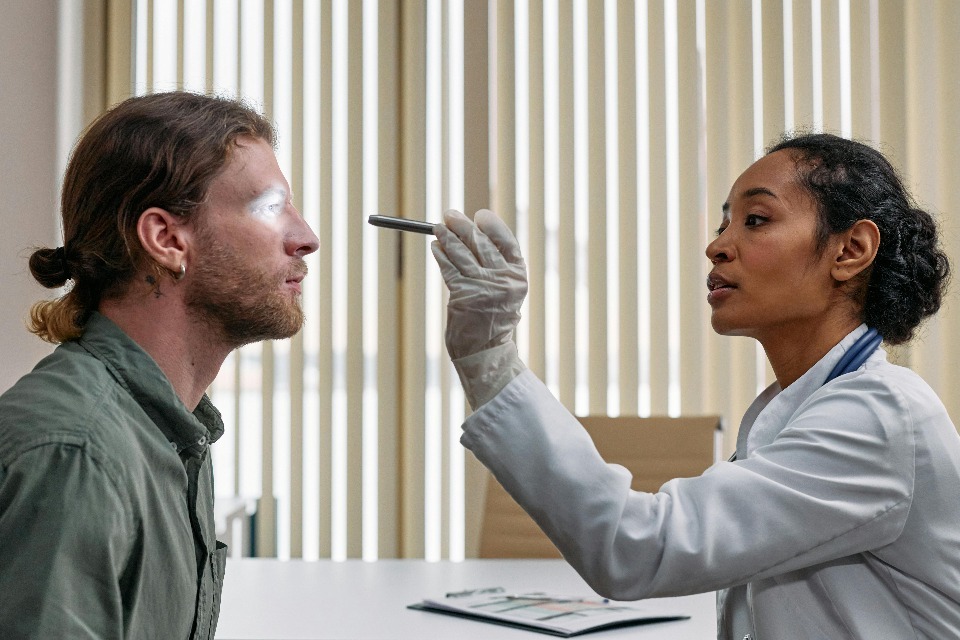
Here’s what to know about this eye condition.
What Is Thyroid Eye Disease?
As antibodies attack cells on the eyes called orbital fibroblasts, they release inflammatory substances called cytokines, explains Andrea Kossler, MD, an associate professor of ophthalmology at Stanford University School of Medicine in Palo Alto, California, and a thyroid eye disease specialist. “This causes pain, swelling, and redness in the eyes,” she says.
Common Symptoms of Thyroid Eye Disease
- Bags under the eyes
- Blurred or double vision
- Bulging/staring eyes
- Decreased eye motility (movement)
- Dry eyes
- Gritty feeling in the eyes
- Low tolerance to bright lights
- Pain
- Redness
- Swelling
- Tearing
How Is Thyroid Eye Disease Diagnosed and Monitored?
“Thyroid eye disease is commonly misdiagnosed,” says Kossler. “It can take moderate or severe disease before it’s correctly diagnosed.” If you notice common signs and symptoms, such as eye pain, redness, swelling, or a change in the appearance of your eyes, she recommends seeing an ophthalmologist to get lab work done to rule out thyroid eye disease.
How Is Thyroid Eye Disease Treated?
There are several treatment options for thyroid eye disease. “If you have thyroid eye disease, it’s extremely important to see your endocrinologist to get your thyroid under control,” says Kossler. While this does not treat thyroid eye disease itself, she says, it’s an important first step.
- Selenium plays a key role in thyroid function. Research has found selenium supplements to be beneficial in the management of mild eye disease. Taking this antioxidant supplement may help decrease the progression of thyroid eye disease in people who have mild-to-moderate forms of the condition, says Kossler. Your doctor may also recommend eating Brazil nuts, which are naturally rich in the mineral.
- Artificial tears can help relieve dry eye and redness.
- Dark sunglasses can ease the effects of light sensitivity.
- Fresnel prisms can help address double vision.
- Steroids can help decrease inflammation, puffiness, and swelling.
- Radiation can decrease inflammation of the tissue in the eye socket, but its effectiveness in thyroid eye disease remains uncertain. One review found that radiation can improve some symptoms of thyroid eye disease, but more research is needed.
- Surgery can correct eye and eyelid position.
- An intravenous infusion can help prevent inflammation and decrease proptosis (eye bulging).
The treatment that’s right for you will depend on whether you have a mild, moderate, or severe case of the disease, says Kossler. Your doctor will also take your personal health history into consideration.
Thyroid eye disease sometimes subsides on its own, without treatment, she says, so doctors will take a watch-and-wait approach with some people. If the symptoms of thyroid eye disease are interfering with your quality of life, your doctor may recommend using artificial tears.
Potential Complications
Research and Advances
Teprotumumab is a major advancement in the treatment of thyroid eye disease. It is a monoclonal antibody that has been shown to improve double vision, reduce proptosis, and reverse the restructuring of orbital tissue caused by thyroid eye disease.
- RVT-1401, a monoclonal antibody that may reduce proptosis and slow the overproduction of thyroid hormones
- Statins, which studies have shown can improve double vision and eyelid opening
- Belimumab, a monoclonal antibody that can improve overall thyroid eye disease symptoms
- Local injection of corticosteroid into the eye socket to reduce inflammation and pain
- Anti–vascular endothelial growth factor, which decreases the blood vessel density associated with thyroid eye disease
- VRDN-001, a monoclonal antibody similar to teprotumumab, but with more convenient dosing
Discuss the options with your ophthalmologist and/or endocrinologist to find the best treatment for you. They can also go over the latest medications approved for treatment. According to Ilya Leyngold, MD, an oculofacial surgeon in Meridien, Idaho, there is currently a lot of ongoing research dedicated to improving treatment options for people with thyroid eye disease. “The goal in the future is centered on minimizing the costs and improving how the drugs are administered,” says Dr. Leyngold.
The Takeaway
Thyroid eye disease is a chronic condition that requires monitoring with regular checkups. The disorder can be managed with treatments to help reduce and control symptoms. And research will continue to expand ways to help people preserve their vision and reduce their risk of complications.
link







